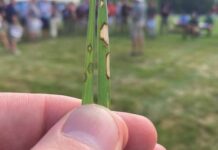Summarized from an article in The Purdue University Landscape Report By Janna Beckerman.
Wet summer weather always brings in a surplus of plant diseases, but few are as dramatic as clematis blight (sometimes called clematis wilt), caused by the fungus Calophoma clematidina.

Clematis blight causes dead leaf spots that appear during wet weather, from late Spring throughout Summer. The spots are often light brown in the center with a dark ring between dead and healthy tissue. The edges of the spots may be defined by leaf veins, creating an irregular, mosaic appearance. Small, black pustules may be seen within the spots when using a hand lens.

Blight is “a disease or injury of plants marked by the formation of lesions, withering, and death of parts (such as leaves and tubers)”. If the foliage is affected earlier than the stems, leaves turn brown and ‘blight.’ However, if crown or stems are infected first, leaves may wilt and then discolor.
While sometimes called clematis wilt, it should be noted Calophoma is not technically not a “wilt” which infects and spreads through vascular tissue. Calophoma penetrates into the epidermal cells.
Although “Phoma” diseases are challenging, below are some tips for management. (Keep in mind clematis blight is unsightly, but rarely fatal on its own.)
- Location. Start with disease-free material, sited to receive at least six hours of sun per day, keeping plants well-spaced to allow foliage to dry which protects against foliar disease.
- Appropriate pruning. Make sure you know your clematis group to know how and when to prune appropriately. Lee Reich has an excellent article on how to prune each group of clematis. Thick, dense, overgrown clematis provides an extremely conducive environment for this disease, so pruning to improve canopy airflow and to reduce leaf wetness is important to keep plants healthy. Keep in mind that some varieties of clematis only flower on old wood, so pruning to eliminate disease tissue may also eliminate blooms!
- Fungicide Application. After pruning (and when appropriate) preventative applications of fungicides in early Spring through Summer may be needed to keep plants looking good season-long. Daconil Weatherstik, Emblem, Orkestra, Pageant, Palladium, Postiva, and Trinity are all labeled for Phoma control in the landscape. Applications need to begin to protect new growth (early Spring) and continued as per label recommendations during wet weather.
Find the original article and many other topics in the Purdue Landscape Report.
For related topics, see:
Troubleshooting Turfgrass Diseases











![[VIDEO] Dickies®: Discover Workwear That’s Anything But Uniform](https://turfmagazine.com/wp-content/uploads/2023/06/1647663814-4b1a2a7742790a9b1e97a3b963477850192e1d6a9dfba9b07214a77bae25d6e3-d-218x150.jpg)






























![[VIDEO] Dickies®: Discover Workwear That’s Anything But Uniform](https://turfmagazine.com/wp-content/uploads/2023/06/1647663814-4b1a2a7742790a9b1e97a3b963477850192e1d6a9dfba9b07214a77bae25d6e3-d-324x160.jpg)